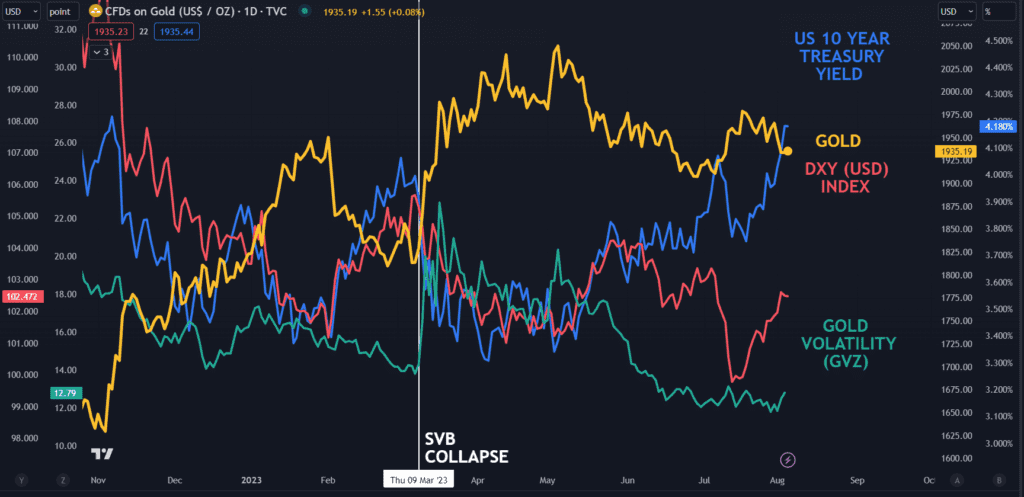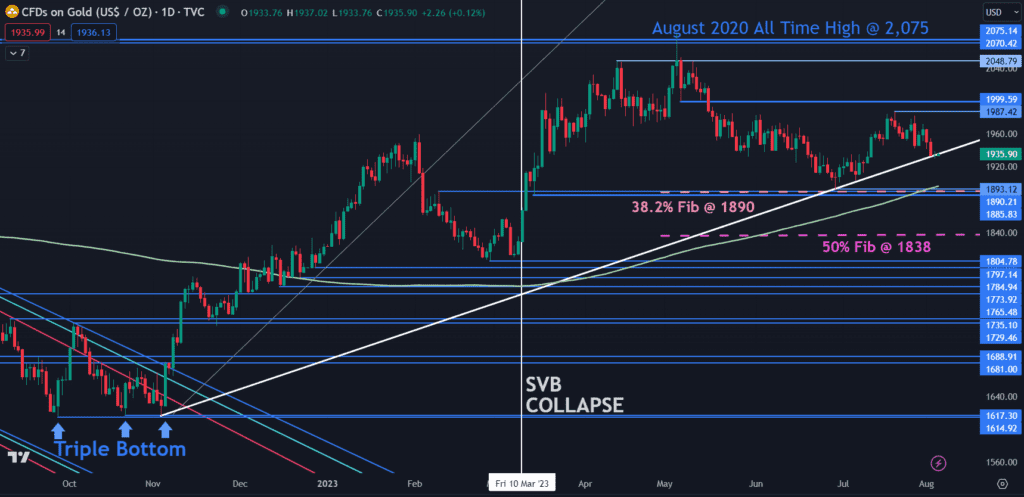With the gold price at crossroads, the global financial markets are witnessing heightened volatility as it grapples with surging US Dollar and Treasury Yields. While other assets experience significant action, the precious metal XAU/USD appears to be sidelined. As risk aversion takes center stage, investors are closely monitoring the uncertain landscape and pondering the direction of gold. With non-farm payrolls data looming on the horizon, this article delves deeper into the factors influencing the gold market and explores what lies ahead for this safe-haven asset.
Gold Price at Crossroads and the US Dollar-Treasury Yields Nexus
The recent Fitch downgrade of US sovereign debt credit rating from AAA to AA+ sent shockwaves through financial markets, igniting risk-off sentiment. Amidst this backdrop, the gold price has been relatively subdued, while the US Dollar and Treasury Yields have found firmer footing. Investors are seeking refuge in the US Dollar and US Treasuries, pushing yields higher, as concerns about the country’s debt levels and balance sheet deterioration grow.
The Fitch downgrade, although not unexpected, acted as a catalyst for increased market volatility. Treasury Secretary Janet Yellen’s dismissal of the move as ‘arbitrary’ and ‘outdated’ did little to assuage fears. Instead, it raised further questions about the stability of the US economy and the potential repercussions on global financial markets.
Growing Cost of Treasury Borrowing
Adding to the unease, the US Department of Treasury announced plans to issue a staggering US$ 103 billion in the coming week, a sharp increase from the previous issuance. This move signals the growing cost of Treasury borrowing, as investors demand higher returns to compensate for perceived term risk. The yield on the benchmark 10-year note is surging toward 4.20%, a level not seen since November last year, after dipping to 4.73% just a fortnight ago.

Source: dailyFX
The surge in yields has been most pronounced in the back end of the yield curve, reflecting the rising concern over the US government’s balance sheet and the long-term sustainability of its debt levels. On the other hand, the short end of the Treasury curve seems more anchored, with the market increasingly convinced that the Federal Reserve is approaching the end of its tightening cycle.
Implied Volatility for Gold
The GVZ index, a measure of implied volatility for gold akin to the VIX index for the S&P 500, has witnessed a recent uptick. While forward-looking gold volatility has been somewhat stagnant, the recent increase suggests growing uncertainty within the market and hints at potential significant price movements ahead.
Investors are closely monitoring volatility in the gold market as it indicates market participants’ perception of risk. Higher volatility can be indicative of increased uncertainty and anxiety, which can attract investors to safe-haven assets like gold. However, it is essential to note that volatility itself is not a directional indicator, and investors must carefully analyze other factors before making investment decisions.
Gold Technical Analysis Snapshot
In the midst of these headwinds, the gold price is currently testing trend line support. A decisive break lower could lead to further support around the 1885 – 1895 area, characterized by a cluster of prior lows, a significant breakpoint, the 200-day simple moving average (SMA), and the 38.2% Fibonacci Retracement level. A deeper decline might find support near the 50% Fibonacci Retracement at 1838, a key level watched by technical traders.
Conversely, if the gold price manages to reverse its current downtrend, it may encounter resistance near the recent peak of 1897 or the breakpoint near 2000. Technical traders are closely monitoring these levels to gauge potential price movements.
Non-Farm Payrolls Data Awaited
The ongoing volatility and uncertainty in the financial markets are further compounded by the imminent release of non-farm payrolls data. This economic indicator, published by the US Bureau of Labor Statistics on the first Friday of each month, provides valuable insights into the health of the US labor market. Employment data is a crucial driver of economic growth, and its release can have a significant impact on market sentiment, including precious metals like gold.

Investors, analysts, and policymakers scrutinize the non-farm payrolls data as it influences Federal Reserve decisions regarding monetary policy and interest rates. A stronger-than-expected report can bolster confidence in the US economy, leading to speculation about future interest rate hikes. On the other hand, disappointing data may fuel concerns about economic slowdown and potential rate cuts. Both scenarios can have implications for gold prices, as they affect the opportunity cost of holding the precious metal.
Conclusion
As the gold price stands at a crossroads, influenced by the surging US Dollar and Treasury Yields, market participants are treading cautiously. Volatility is on the rise, and all eyes are on the impending release of non-farm payrolls data. Investors must stay vigilant and nimble, ready to adapt to the evolving market conditions. The gold market remains an intriguing space to watch, with potential opportunities and risks aplenty.
Amidst the turmoil, the allure of gold as a safe-haven asset persists, but its direction will be influenced by multiple factors beyond the scope of this analysis. Market participants should approach trading and investing in gold with a comprehensive understanding of the macroeconomic and geopolitical landscape, keeping in mind that market sentiment can shift rapidly in response to new information and events.
Click here to read our latest article on the Dollar Boost Reaching 4 Week Peak

